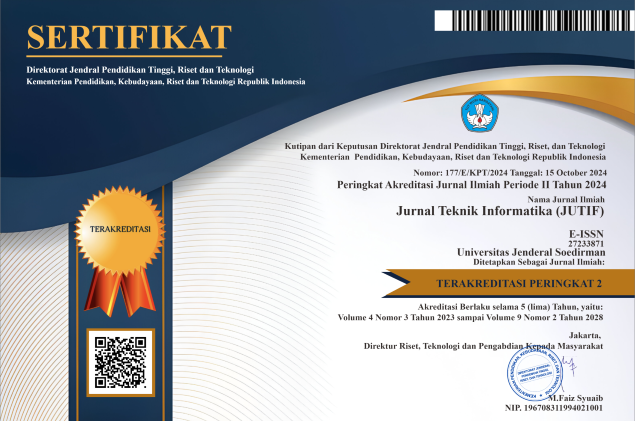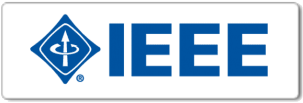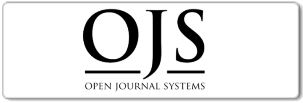HYBRID METHOD USING NON-NEGATIVE MATRIX FACTORIZATION AND KEYWORD-BASED FILTERING FOR RECOMMENDER SYSTEM IN MOOCS
DOI:
https://doi.org/10.52436/1.jutif.2025.6.1.3605Keywords:
Hybrid Method, Keyword-Based Filtering, Massive Open Online Courses, Non-Negative Matrix Factorization, Recommender SystemAbstract
Massive Open Online Courses (MOOCs), introduced by Dave Cormier in 2008, have revolutionized education by providing widespread access to open and participatory online learning. While MOOCs offer broad access and flexibility in learning, users often encounter challenges in selecting appropriate courses. This leads to high dropout rates. To address this issue, this research develops a recommendation system employing the Weighted Hybrid method that combines Non-Negative Matrix Factorization (NMF) and Keyword-Based Filtering (KBF). The primary objective of the research is to enhance the accuracy of course recommendations on MOOCs. The findings of this study demonstrate that the Weighted Hybrid method, integrating NMF and KBF, successfully attained a Mean Average Precision (MAP) of 0.1963. This figure signifies an improvement compared to the MAP value of 0.1855 achieved in prior research. This method effectively addresses challenges such as cold start and sparsity, while also improving scalability. Consequently, the Weighted Hybrid approach holds promise for improving the quality of recommendations, enhancing the user's learning experience, and potentially reducing dropout rates in MOOCs.
Downloads
References
S. Symonenko, N. Zaitseva, and V. Osadchyi, “Implementation of MOOC platforms into teaching English to IT specialists,” SHS Web of Conferences, vol. 104, p. 03007, 2021, doi: 10.1051/shsconf/202110403007.
C. M. Stracke, S. Downes, G. Conole, D. Burgos, and F. Nascimbeni, “Are MOOCs Open Educational Resources? A literature review on history, definitions and typologies of OER and MOOCs,” Open Praxis, vol. 11, no. 4, p. 331, Dec. 2019, doi: 10.5944/openpraxis.11.4.1010.
D. Shah, “By The Numbers: MOOCs in 2021,” The Report. Accessed: Oct. 05, 2023. [Online]. Available: https://www.classcentral.com/report/mooc-stats-2021/
A. Mcauley, B. Stewart, G. Siemens, and D. Cormier, “THE MOOC MODEL FOR DIGITAL PRACTICE: Digital ways of knowing and learning,” 2010. [Online]. Available: http://www.flickr.com/photos/ecstaticist/3570660643/
I. Arpaci, M. Al-Emran, and M. A. Al-Sharafi, “The impact of knowledge management practices on the acceptance of Massive Open Online Courses (MOOCs) by engineering students: A cross-cultural comparison,” Telematics and Informatics, vol. 54, Nov. 2020, doi: 10.1016/j.tele.2020.101468.
W. M. Al-Rahmi, N. Yahaya, M. M. Alamri, I. Y. Alyoussef, A. M. Al-Rahmi, and Y. Bin Kamin, “Integrating innovation diffusion theory with technology acceptance model: supporting students’ attitude towards using a massive open online courses (MOOCs) systems,” Interactive Learning Environments, vol. 29, no. 8, pp. 1380–1392, 2021, doi: 10.1080/10494820.2019.1629599.
Y. Aljaraideh, “Massive Open Online Learning (MOOC) benefits and challenges: A case study in Jordanian context,” International Journal of Instruction, vol. 12, no. 4, pp. 65–78, Oct. 2019, doi: 10.29333/iji.2019.1245a.
R. Corrado, E. Pretorius, and G. Van Der Westhuizen, “Undergraduate students’ experiences of the use of moocs for learning at a cambodian university,” Educ Sci (Basel), vol. 11, no. 7, Jul. 2021, doi: 10.3390/educsci11070336.
J. S. Brereton and K. Young, “Establishing Social Learning in an Engineering MOOC: Benefits for Diversity and Inclusion in Engineering Education,” Sustainability (Switzerland), vol. 14, no. 9, May 2022, doi: 10.3390/su14095472.
K. R. M. Rafiq, H. Hashim, and M. Md Yunus, “MOOC for Training: How Far It Benefits Employees?,” in Journal of Physics: Conference Series, Institute of Physics Publishing, Dec. 2019. doi: 10.1088/1742-6596/1424/1/012033.
S. Edelsbrunner, K. Steiner, S. Schön, M. Ebner, and P. Leitner, “Promoting Digital Skills for Austrian Employees through a MOOC: Results and Lessons Learned from Design and Implementation,” Educ Sci (Basel), vol. 12, no. 2, Feb. 2022, doi: 10.3390/educsci12020089.
M. Mehrabi, A. R. Safarpour, and A. A. Keshtkar, “Massive Open Online Courses (MOOCs) Dropout Rate in the World: A Protocol for Systematic Review and Meta-analysis,” Interdiscip J Virtual Learn Med Sci, vol. 13, no. 2, p. 86, 2022, doi: 10.30476/IJVLMS.2022.94572.1138.
P. Topali, A. Ortega-Arranz, E. Er, A. Martínez-Monés, S. L. Villagrá-Sobrino, and Y. Dimitriadis, “Exploring the problems experienced by learners in a MOOC implementing active learning pedagogies,” in Lecture Notes in Computer Science (including subseries Lecture Notes in Artificial Intelligence and Lecture Notes in Bioinformatics), Springer Verlag, 2019, pp. 81–90. doi: 10.1007/978-3-030-19875-6_10.
P. Topali, A. Ortega-Arranz, A. Martínez-Monés, and S. L. Villagrá-Sobrino, “‘Houston, we have a problem’: Revealing MOOC practitioners’ experiences regarding feedback provision to learners facing difficulties,” Computer Applications in Engineering Education, vol. 29, no. 4, pp. 769–785, Jul. 2021, doi: 10.1002/cae.22360.
C. Chen, G. Sonnert, P. M. Sadler, D. D. Sasselov, C. Fredericks, and D. J. Malan, “Going over the cliff: MOOC dropout behavior at chapter transition,” Distance Education, vol. 41, no. 1, pp. 6–25, Jan. 2020, doi: 10.1080/01587919.2020.1724772.
G. R. El Said, “Understanding How Learners Use Massive Open Online Courses and Why They Drop Out,” Journal of Educational Computing Research, vol. 55, no. 5, pp. 724–752, Sep. 2017, doi: 10.1177/0735633116681302.
M. Garreta-Domingo, P. B. Sloep, and D. Hernández-Leo, “Human-centred design to empower ‘teachers as designers,’” British Journal of Educational Technology, vol. 49, no. 6, pp. 1113–1130, Nov. 2018, doi: 10.1111/bjet.12682.
J. Goopio and C. Cheung, “The MOOC dropout phenomenon and retention strategies,” Journal of Teaching in Travel and Tourism, vol. 21, no. 2, pp. 177–197, 2021, doi: 10.1080/15313220.2020.1809050.
J. Wang, P. Lin, Y. Li, R. Xu, P. Nie, and Y. Xu, “Problems and solutions of MOOC application in provincial colleges and universities,” in The 14th International Conference on Computer Science & Education (ICCSE 2019), 2019, pp. 796–801.
K. Rabahallah, L. Mahdaoui, and F. Azouaou, “MOOCs recommender system using ontology and memory-based collaborative filtering,” in ICEIS 2018 - Proceedings of the 20th International Conference on Enterprise Information Systems, SciTePress, 2018, pp. 635–641. doi: 10.5220/0006786006350641.
Y. Wang, B. Liang, W. Ji, S. Wang, and Y. Chen, “An improved algorithm for personalized recommendation on MOOCs,” International Journal of Crowd Science, vol. 1, no. 3, pp. 186–196, Sep. 2017, doi: 10.1108/IJCS-08-2017-0021.
I. Fahrurrozi, E. M. D. Admoko, and A. Susilo, “PERBANDINGAN METODE COLLABORATIVE FILTERING DAN HYBRID SEMANTIC SIMILARITY,” Jurnal Nasional Teknologi Terapan, vol. 2, no. 3, pp. 334–342, 2018.
S. Sylvia and S. Lestari, “Implementasi K-Means Dalam Mengatasi Masalah Cold Star Pada Collaborative Filtering,” in Seminar Nasional Hasil Penelitian dan Pengabdian Masyarakat, 2022, pp. 58–63.
E. Çano and M. Morisio, “Hybrid recommender systems: A systematic literature review,” 2017, IOS Press. doi: 10.3233/IDA-163209.
K. B. P. Jati, A. T. Wibowo, and R. Rismala, “Implementasi dan Analisis Online-Updating Regularization Kernel Matrix Factorization Model pada Sistem Rekomendasi,” e-Proceeding of Engineering, vol. 2, no. 2, pp. 6378–6386, 2015.
H. Nurrahmi, A. T. Wibowo, and S. Meliana, “Non-Negative Matrix Factorization Based Recommender System using Female Daily Implicit Feedback,” Ind. Journal on Computing, vol. 7, no. 1, pp. 1–14, 2022, doi: 10.34818/indojc.2022.7.1.599.
F. B. A. Larasati and H. Februariyanti, “SISTEM REKOMENDASI PRODUCT EMINA COSMETICS DENGAN MENGGUNAKAN METODE CONTENT - BASED FILTERING,” MISI (Jurnal Manajemen informatika & Sistem Informasi) , vol. 4, no. 1, pp. 45–54, 2021.
A. A. Widjaja and H. N. Palit, “Hybrid Recommendation System untuk Peminjaman Buku Perpustakaan dengan Collaborative dan Content-Based Filtering,” JURNAL INFRA, vol. 10, no. 2, pp. 1–6, 2022.
M. I. Fathurrahman, D. Nurjanah, and R. Rismala, “Sistem Rekomendasi pada Buku dengan Menggunakan Metode Trust-Aware Recommendation Recommendation System for book by using Trust-Aware Recommendation Method,” in e-Proceeding of Engineering, 2017, pp. 4966–4977.
S. Souabi, A. Retbi, M. K. Idrissi, and S. Bennani, “Recommendation Systems on E-Learning and Social Learning: A Systematic Review,” The Electronic Journal of e-Learning, vol. 19, no. 5, pp. 432–451, 2021, [Online]. Available: www.ejel.org
J. Joy and R. V. G. Pillai, “Review and classification of content recommenders in E-learning environment,” 2021, King Saud bin Abdulaziz University. doi: 10.1016/j.jksuci.2021.06.009.
E. Erlangga and H. Sutrisno, “Sistem Rekomendasi Beauty Shop Berbasis Collaborative Filtering,” Jurnal Manajemen Sistem Informasi dan Teknologi , vol. 10, no. 2, pp. 47–52, 2020.
H. Februariyanti, A. Dwi Laksono, J. Sasongko Wibowo, and M. Siswo Utomo, “IMPLEMENTASI METODE COLLABORATIVE FILTERING UNTUK SISTEM REKOMENDASI PENJUALAN PADA TOKO MEBEL,” JURNAL KHATULISTIWA INFORMATIKA, vol. 9, no. 1, pp. 43–50, 2021, [Online]. Available: www.unisbank.ac.id
A. E. Wijaya and D. Alfian, “SISTEM REKOMENDASI LAPTOP MENGGUNAKAN COLLABORATIVE FILTERING DAN CONTENT-BASED FILTERING,” Jurnal Computech & Bisnis, vol. 12, no. 1, pp. 11–27, 2018.
I. M. I. Subroto, S. Mulyono, R. Firmansyah, M. Qomaruddin, and E. N. B. Susila, “Sistem Rekomendasi pada Pembelajaran Mobile Menggunakan Metode Cosine Similarity dan Collaborative Filtering,” Jurnal Transistor Elektro dan Informatika (TRANSISTOR EI), vol. 4, no. 1, pp. 21–28, 2022.
P. Parhi, A. Pal, and M. Aggarwal, “A Survey of Methods of Collaborative Filtering Techniques,” in International Conference on Inventive Systems and Control (ICISC-2017), 2017, pp. 1–7.
A. Adawiyyah and S. R. Nudin, “Penerapan Algoritma Content Based Filtering dan Frequent Pattern Growth pada Sistem Rekomendasi Program Mahasiswa Wirausaha di Universitas Negeri Surabaya,” Journal of Informatics and Computer Science, vol. 3, no. 2, pp. 123–130, 2021.
M. B. S. Siddik and A. T. Wibowo, “Collaborative Filtering Based Food Recommendation System Using Matrix Factorization,” Jurnal Media Informatika Budidarma, vol. 7, no. 3, pp. 1041–1049, 2023, doi: 10.30865/mib.v7i3.6049.
K. K. Jena et al., “E-Learning Course Recommender System Using Collaborative Filtering Models,” Electronics (Switzerland), vol. 12, no. 1, Jan. 2023, doi: 10.3390/electronics12010157.
A. N. Khusna, K. P. Delasano, and D. C. E. Saputra, “Penerapan User-Based Collaborative Filtering Algorithm Studi Kasus Sistem Rekomendasi untuk Menentukan Gadget Shield,” MATRIK : Jurnal Manajemen, Teknik Informatika dan Rekayasa Komputer, vol. 20, no. 2, pp. 293–304, May 2021, doi: 10.30812/matrik.v20i2.1124.
A. ’Alim, A. Solichin, and Painem, “Rekomendasi Keterampilan Teknologi Informasi Menggunakan Metode User-Based Collaborative Filtering dan Log-Likelihood Similarity,” Cogito Smart Journal, vol. 6, no. 2, pp. 141–154, 2020.
M. Zarlis, R. Widia Sembiring, S. Tunas Bangsa Pematangsiantar, and J. A. Jend Sudirman Blok No, “ANALISA TERHADAP PERBANDINGAN ALGORITMA DECISION TREE DENGAN ALGORITMA RANDOM TREE UNTUK PRE-PROCESSING DATA,” Jurnal Sains Komputer & Informatika (J-SAKTI, no. 1, 2017, [Online]. Available: http://tunasbangsa.ac.id/ejurnal/index.php/jsakti
N. Sagala and H. Tampubolon, “Kinerja Algoritma Data Mining pada Dataset Konsumsi Alkohol Siswa,” Jurnal Ilmu Komputer dan Informatika, vol. 4, no. 2, pp. 98–103, 2018.
E. Etriyanti, D. Syamsuar, and Y. N. Kunang, “Implementasi Data Mining Menggunakan Algoritme Naive Bayes Classifier dan C4.5 untuk Memprediksi Kelulusan Mahasiswa,” Telematika, vol. 13, no. 1, pp. 56–67, Feb. 2020, doi: 10.35671/telematika.v13i1.881.
A. Izzah and R. Widyastuti, “Prediksi Harga Saham Menggunakan Improved Multiple Linear Regression untuk Pencegahan Data Outlier,” KINETIK, vol. 2, no. 3, pp. 141–150, Jul. 2017, doi: 10.22219/kinetik.v2i3.268.
E. D. Wahyuni, A. A. Arifiyanti, and M. Kustyani, “Exploratory Data Analysis dalam Konteks Klasifikasi Data Mining,” in Prosiding Nasional Rekayasa Teknologi Industri dan Informasi XIV Tahun 2019 (ReTII), 2019, pp. 263–269. [Online]. Available: http://journal.itny.ac.id/index.php/ReTII
H. Sulastri and A. I. Gufroni, “PENERAPAN DATA MINING DALAM PENGELOMPOKAN PENDERITA THALASSAEMIA,” Jurnal Nasional Teknologi dan Sistem Informasi, vol. 3, no. 2, pp. 299–305, Sep. 2017, doi: 10.25077/teknosi.v3i2.2017.299-305.
V. R. Prasetyo, M. Mercifia, A. Averina, L. Sunyoto, and Budiarjo, “PREDIKSI RATING FILM PADA WEBSITE IMDB MENGGUNAKAN METODE NEURAL NETWORK,” NERO: Networking Engineering Research Operation, vol. 7, no. 1, pp. 1–8, 2022.
F. Astuti, R. M. Candra, S. Agustian, and S. Ramadhani, “Klasifikasi Sentimen Masyarakat Terhadap Pemerintah Terkait Penerapan Kebijakan New Normal Menggunakan Metode K-Nearest Neighbor,” Jurnal Nasional Komputasi dan Teknologi Informasi, vol. 5, no. 3, pp. 531–538, 2022.
I. Yoshua and H. Bunyamin, “Pengimplementasian Sistem Rekomendasi Musik Dengan Metode Collaborative Filtering,” Jurnal Strategi, vol. 3, no. 1, pp. 1–16, 2021.
M. H. Aghdam, M. Analoui, and P. Kabiri, “Collaborative filtering using non-negative matrix factorisation,” J Inf Sci, vol. 43, no. 4, pp. 567–579, Aug. 2017, doi: 10.1177/0165551516654354.
G. M. Del Corso and F. Romani, “Adaptive nonnegative matrix factorization and measure comparisons for recommender systems,” Appl Math Comput, vol. 354, pp. 164–179, Aug. 2019, doi: 10.1016/j.amc.2019.01.047.
Z. Yang, W. Chen, and J. Huang, “Enhancing recommendation on extremely sparse data with blocks-coupled non-negative matrix factorization,” Neurocomputing, vol. 278, pp. 126–133, Feb. 2018, doi: 10.1016/j.neucom.2017.04.080.
H. H. Arfisko and A. T. Wibowo, “Sistem Rekomendasi Film Menggunakan Metode Hybrid Collaborative Filtering Dan Content-Based Filtering,” e-Proceeding of Engineering, vol. 9, no. 3, pp. 2149–2159, 2022.
M. E. B. H. Kbaier, H. Masri, and S. Krichen, “A personalized hybrid tourism recommender system,” in Proceedings of IEEE/ACS International Conference on Computer Systems and Applications, AICCSA, IEEE Computer Society, Jul. 2017, pp. 244–250. doi: 10.1109/AICCSA.2017.12.
S. Suriati, M. Dwiastuti, and T. Tulus, “Weighted hybrid technique for recommender system,” in Journal of Physics: Conference Series, Institute of Physics Publishing, Dec. 2017. doi: 10.1088/1742-6596/930/1/012050.


























